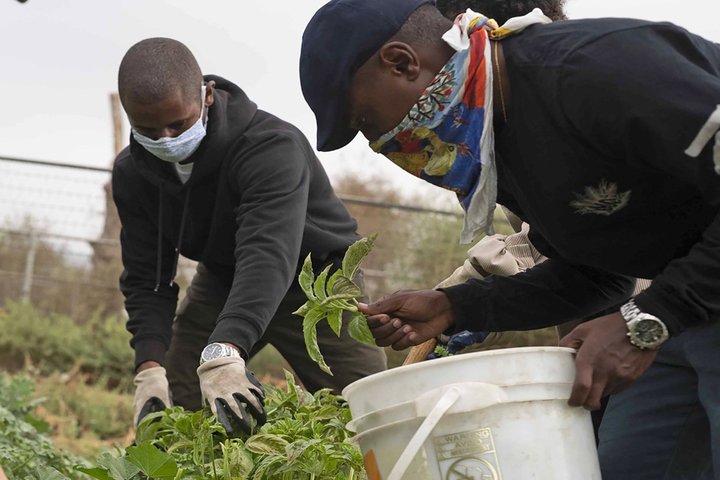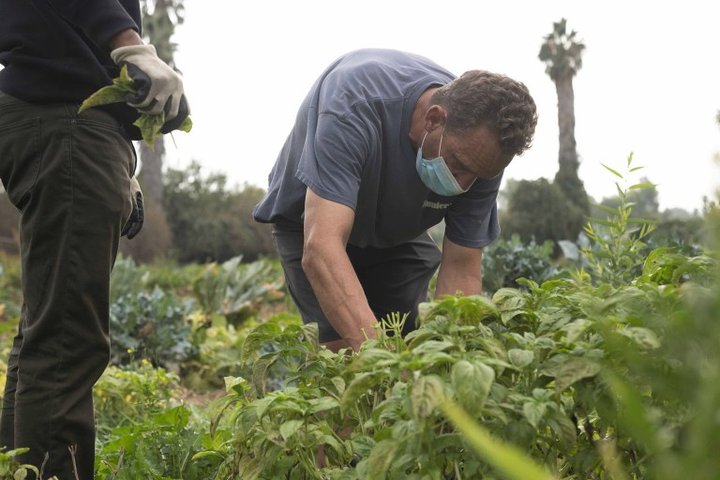
Hawie Mekbib, 26, right, and his 20-year-old brother Yarred help prune basil at Overflow Farms in Riverside County on Oct. 10, 2020. Members of a mutual aid network volunteer once a week at the farm in exchange for produce to share with the community. Photo by Tash Kimmell for CalMatters
###
Every Thursday evening on a small one-acre vegetable farm in the rustic town of Jurupa Valley, Aram Ayra and other volunteers make good on an agreement with the farm’s owner. For two hours they pull weeds, rearrange irrigation hoses and harvest the farm’s wide array of crops — corn, squash, cabbage, lettuce, basil and more. In return, they keep part of the week’s harvest to distribute through a food program.
Ayra is the founder of the Riverside Mutual Aid Network, part of a national movement that sprung up this spring offering food and other forms of relief as the coronavirus pandemic sent the economy into a nosedive. Mutual aid works by asking members to organize and pool resources to meet a community’s most basic needs. For organizers and volunteers, this type of selfless work offers an antidote to government’s inadequate response as the recession accelerates income inequality and casts countless working households over the brink.
“The whole point of them is that they put agency and self-sufficiency back in the hands of the communities and allow them to essentially determine how resources should be allocated,” Ayra said.
But while the pandemic pushes more Californians into poverty, it’s not clear how many people can be helped through mutual aid or how long the groups will stick around. By design, each branch resists hierarchy and lacks the traditional organizational structure of a nonprofit or charity. So while mutual aid chapters continue to practice vigilante volunteerism, it’s too soon to tell if the movement will achieve sustainability or if people will simply lose interest.
“It’s wonderful that these movements are emerging,” said Rocio Rosales, a professor of sociology at UC Irvine who studies informal economies and mutual aid practices by Los Angeles’ immigrant communities. “But it’s really hard to sustain them in the long run if all the members that are helping each other out never rise out of poverty.”

Aram Ayra, a lead organizer with Riverside Mutual Aid Network, harvests yellow squash at Overflow Farms in Riverside County on Oct. 10, 2020. Photo by Tash Kimmell for CalMatters
Mutual aid is not a new concept. Russian philosopher Peter Kropotkin authored a book at the turn of the 20th century called “Mutual Aid: A Factor of Evolution” that explored the need for community cooperation for human survival. In the United States, mutual aid networks have appeared in the absence of economic opportunity and institutional support.
NAACP founder W.E.B. DuBois wrote about Black mutual aid societies. And the Black Panther Party famously practiced mutual aid in the 1970’s through its free breakfast program for children.
More recently, LA organizers began planning for a large-scale mutual aid project years ago. They had anticipated a disastrous event that would create widespread need for mutual aid.
They just thought it would likely come from an earthquake.
Mutual Aid Network L.A. came together in March, a few days before Gov. Gavin Newsom announced his statewide stay-at-home order. The network quickly formed from a collaboration with People Organized for Westside Renewal and Ground Game L.A., two progressive political advocacy groups in Los Angeles, to get up and running.

Local volunteers help prepare farm boxes at Overflow Farms in Riverside County on Oct. 10, 2020. Photo by Tash Kimmell for CalMatters
Other branches, like Riverside Mutual Aid Network, sprung up amid the pandemic and today, there are more than 40 COVID-19 mutual aid groups in California, according to an online directory.
Ayra and co-founder John Stefan, both recent UC Riverside graduates, were looking for a way to help struggling Riverside residents at the onset of the lockdown when they heard about a mutual aid organizing information session hosted by New York Democratic Rep. Alexandria Ocasio-Cortez and Mariame Kaba, a popular police abolition activist.
They realized they didn’t need much to start.
Ayra, who is 23, enlisted the help of friends, most of them fellow classmates, and used GoFundMe donations to launch the Riverside network in March. Requests for assistance come through the organization’s website. The group distributes masks, hygiene kits and volunteers make weekly wellness calls to seniors.
One of its most successful programs is the food distribution program with fresh produce supplied by Overflow Farms, a nonprofit community farm owned by Fred Stover. To date, the network has provided over 1,000 meals to Riverside residents and raised over $5,200.
Without an economic relief package from Sacramento or Washington D.C. in sight, and insufficient unemployment benefits for workers and eviction protections for renters, organizers say the need for mutual aid won’t subside any time soon as the pandemic rages with no clear end in sight. In fact, they hope mutual aid can become a community fixture.

Frederick Stover, 52, the owner of Overflow Farms in Riverside County, shows volunteers how to prune basil on Oct. 10, 2020. Photo by Tash Kimmell for CalMatters
For now, the networks are trying their best to avoid centralizing power. In Riverside, Ayra says a steering committee makes all the key decisions.
While the networks have been adamant about keeping with the egalitarian organizing principle that defines mutual aid, it hasn’t kept them from working with established nonprofit organizations.
Riverside, for example, works with food banks and local nonprofit organizations to fill community gaps. “We see ourselves really as a partner with these groups,” Ayra said. “We support their efforts, but we’re also kind of building our own base, our own foundation for further work on mutual aid.”
Bill Przylucki, a lead organizer with Mutual Aid Network L.A., which raised nearly $500,000 on GoFundMe since it formed in March and amassed hundreds of volunteers, said the group took a pause to reevaluate its network once it felt it had become too top heavy.
In August, the group launched a new approach: distribute resources to smaller nonprofit organizations, such as worker resource centers and tenant rights groups. It also shifted to training people to create smaller, hyperlocal networks at the neighborhood level.
“That’s our vision, really,” Przylucki said. “Groups of 20 to 30 people supporting each other, all over.”
###
This article is part of the California Divide, a collaboration among newsrooms examining income inequity and economic survival in California. CALmatters.org is a nonprofit, nonpartisan media venture explaining California policies and politics.
CLICK TO MANAGE